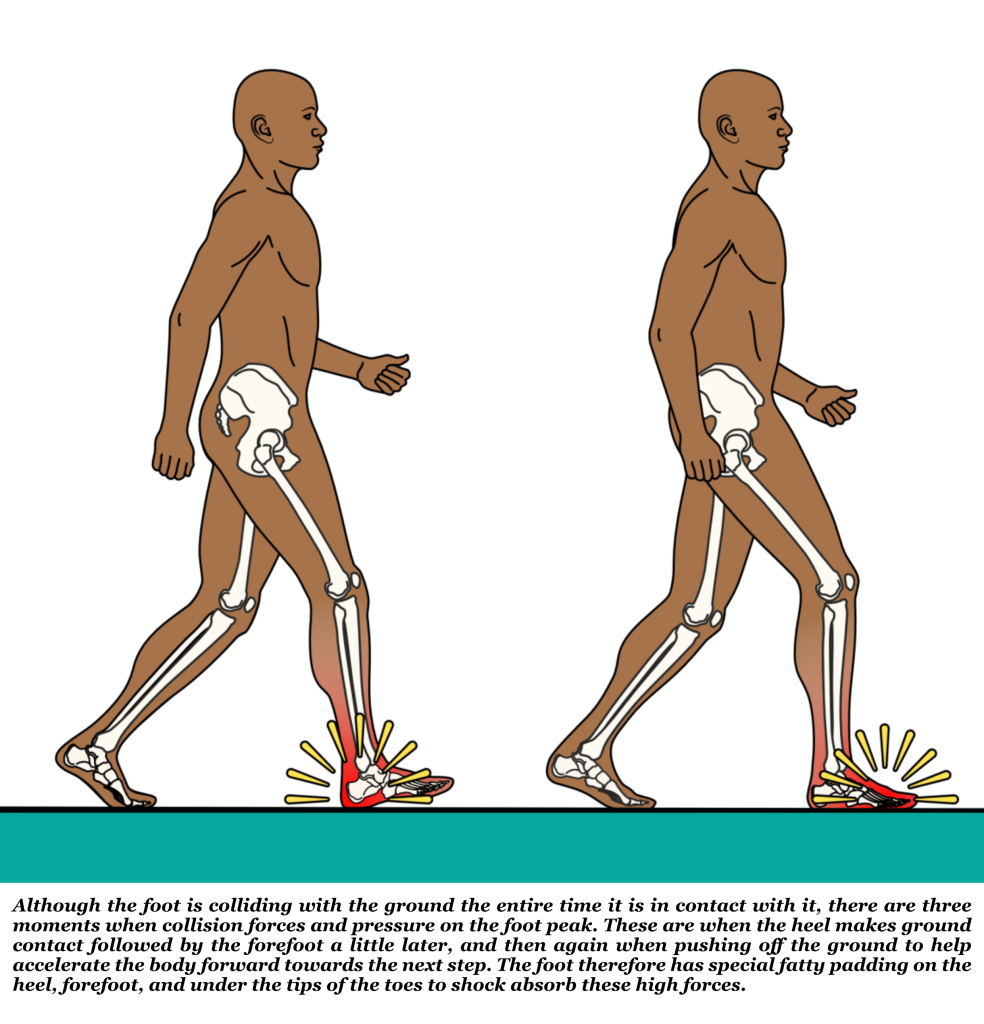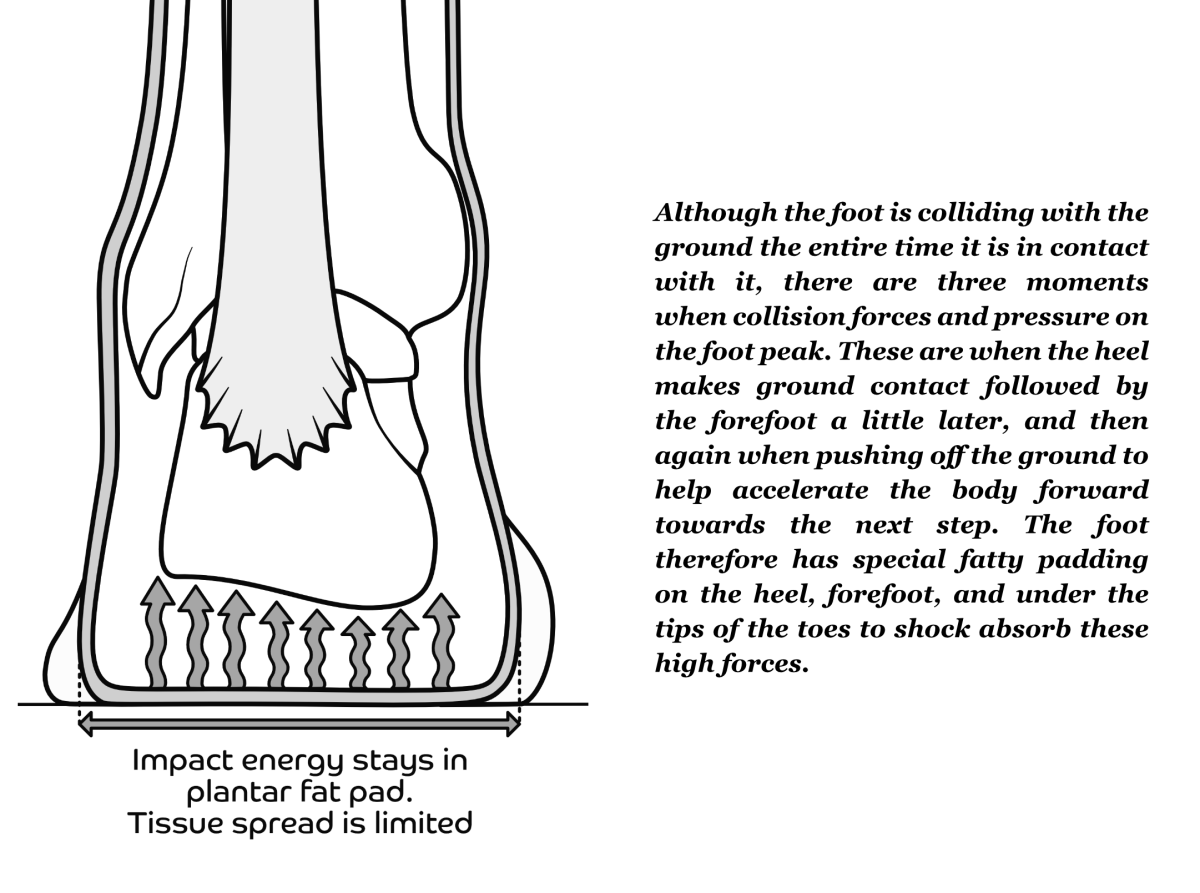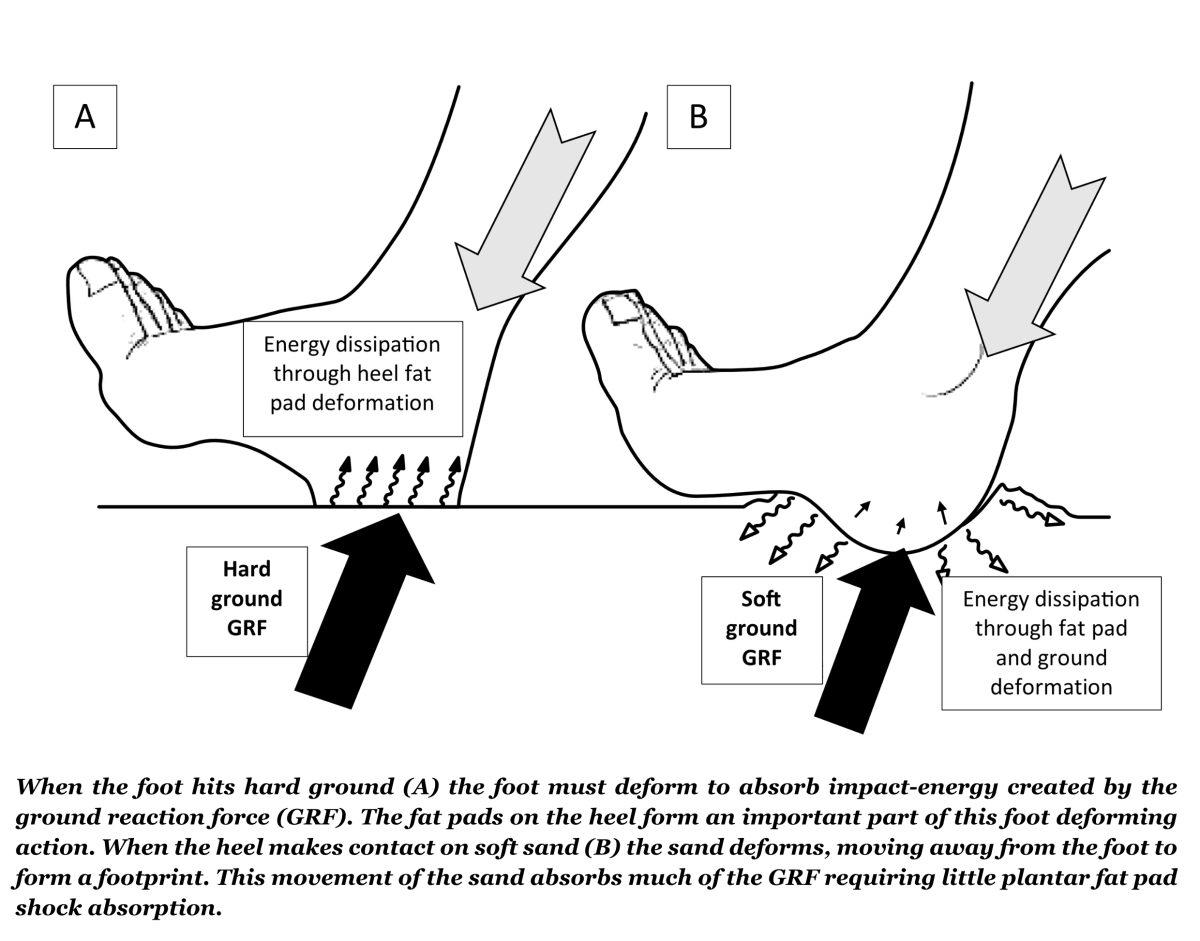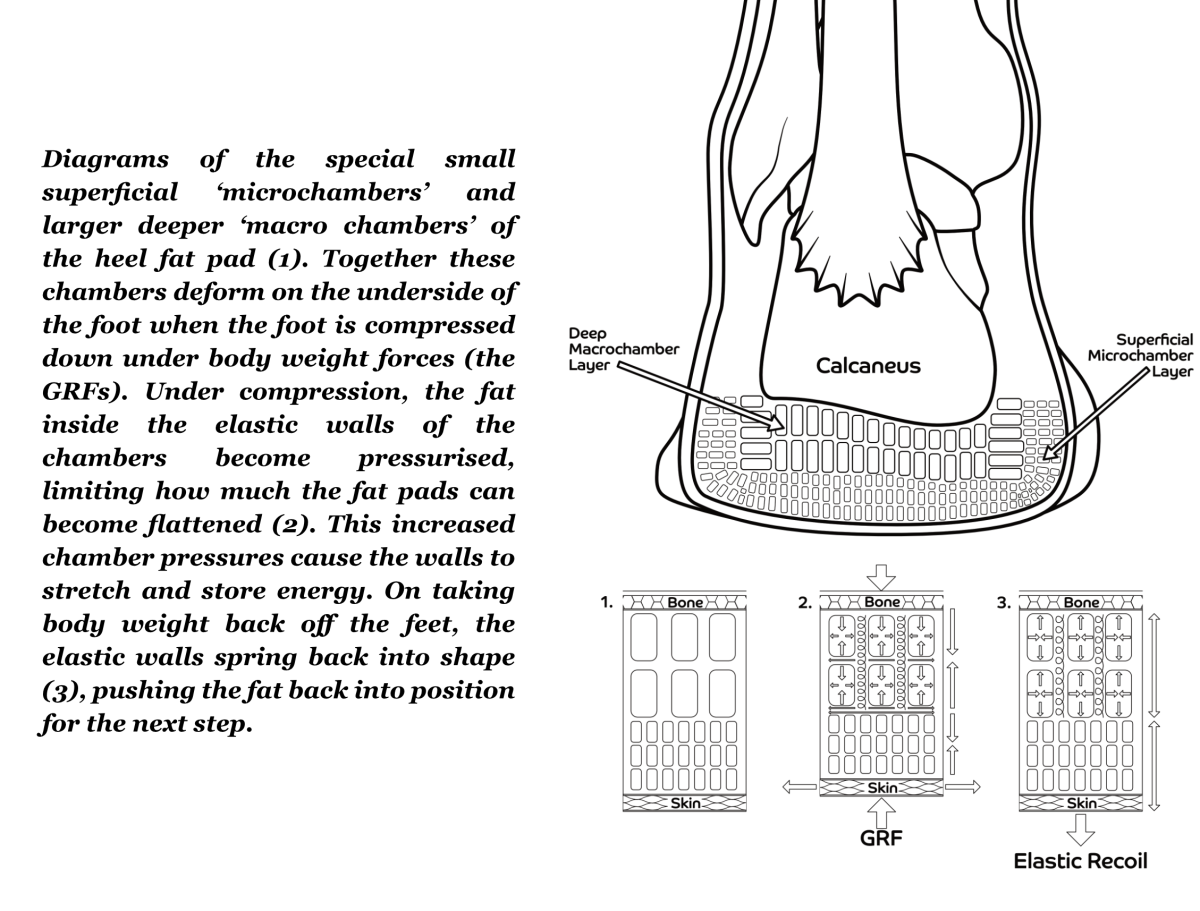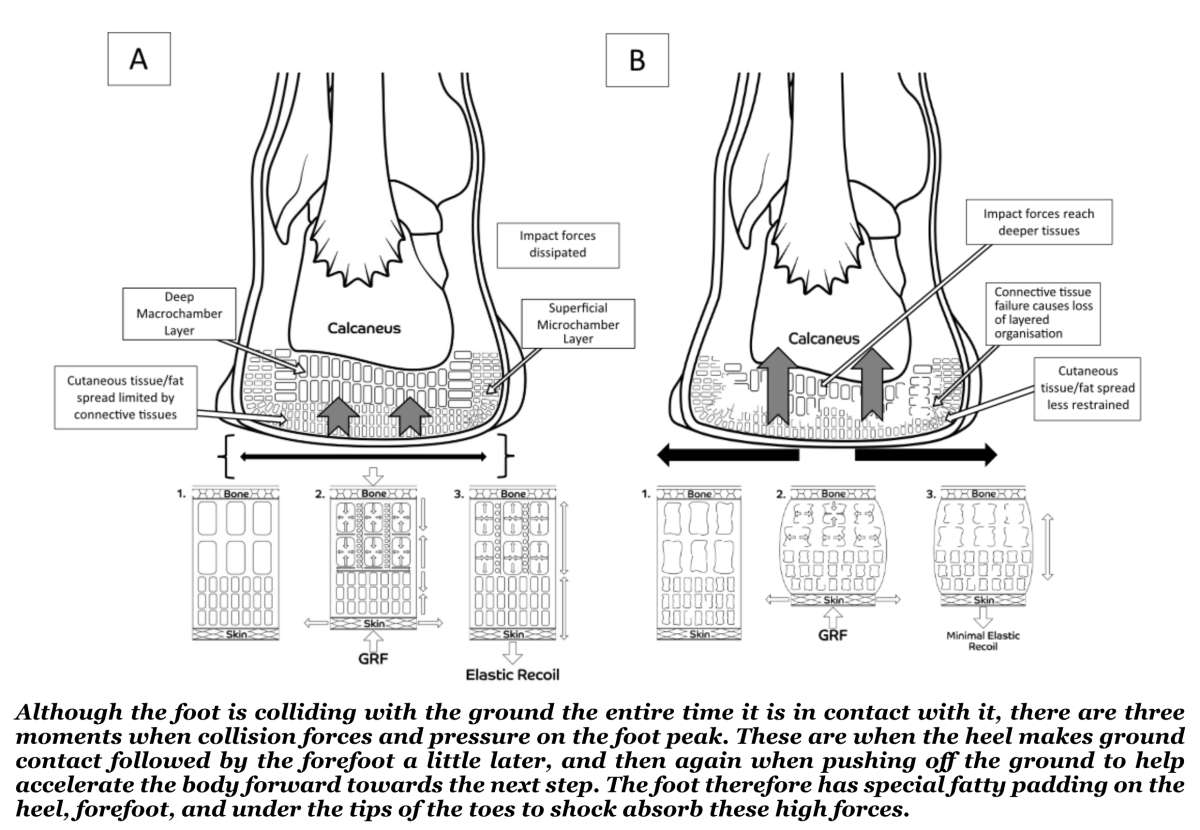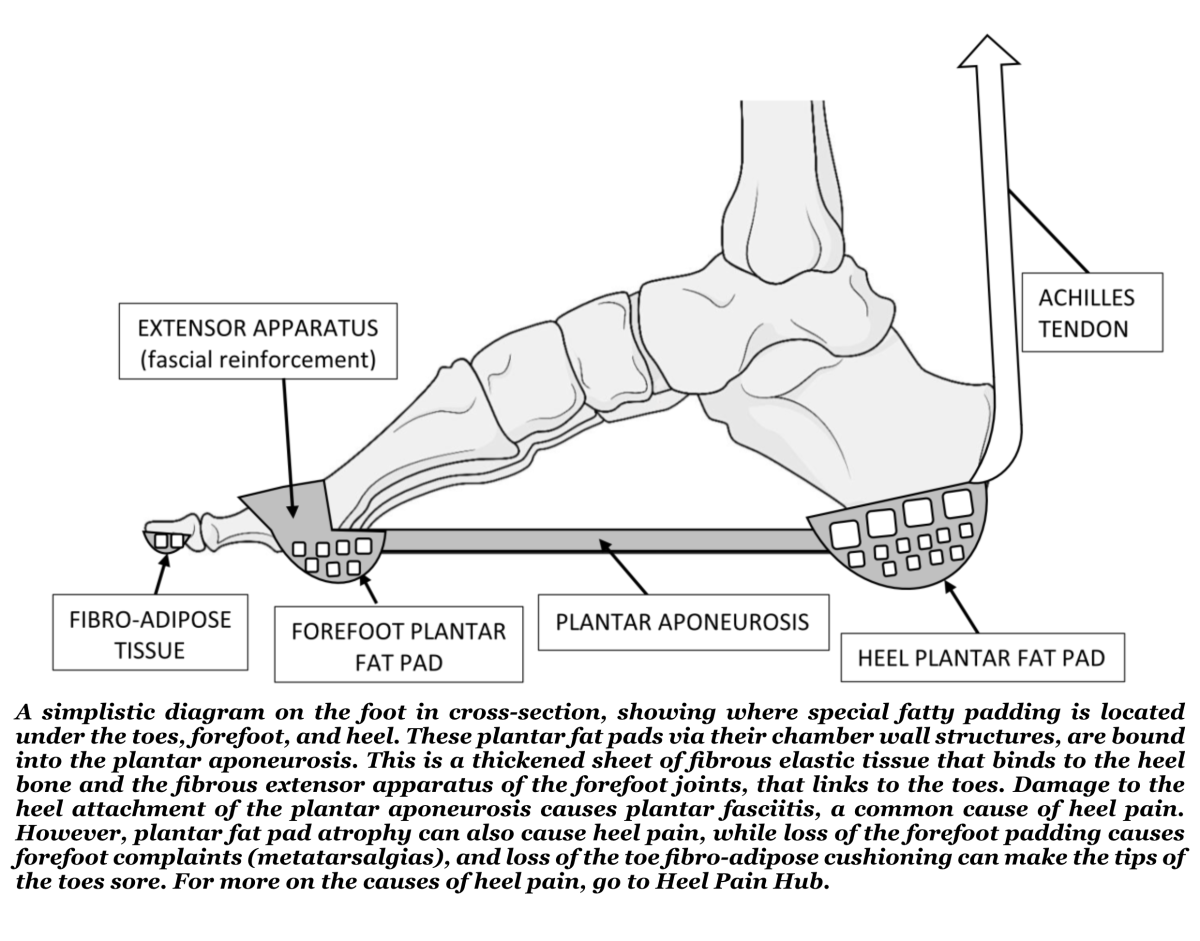Fat Pad Atrophy
Losing the natural cushioning on the feet
The foot is the natural interface between the ground and the body that is subjected to collisions during locomotion. These collisions are brought about by the body weight falling towards the ground at the start of a step and then caused by the foot pushing against the ground as body weight is accelerated forward and off that step and onto the next.
The high forces and pressures that result require shock absorbing pads on the bottom of the feet. Special fatty padding is located under the surface of the heel, the forefoot, and tips of the toes. They are positioned in these locations because when walking, the heel hits the ground first, followed by the forefoot, and finally the toes. These impacts are part of braking events against the fall of body weight towards the ground. When we push forward away from the ground to help drive body weight onto the next step, the heel lifts and the forefoot and toes push firmly into the ground for acceleration.
What protects the foot from the high forces and the powers (energy) generated from first colliding with the ground and then the body pushing down against it, is special tissues designed to deform and shock absorb these impact stresses so that no tissues become injured.
Like Walking on Sand
Foot collisions with the ground can be easily appreciated by walking on wet sand. At heel contact, the heel sinks into the sand while the forefoot and toes sink into it a little later, when the forefoot lands down. However, the forefoot and toes deepen their imprint more during acceleration forward, because forefoot impacts into the sand are greater when pushing back against the ground. Because the sand moves under the impact forces of the foot, the foot’s fatty pads have an easy time, required to deform very little to provide shock absorption. This is because the sand deforms more than the foot, so the sand shock absorbs the impact instead. Indeed, when walking on very soft dry sand, so much force/power is absorbed by the sand moving that accelerating forward becomes hard work. When we walk on harder surfaces the foot must deform instead of the ground and the fatty cushions under the feet become very important for walking comfort. These forces generated between the ground and the foot are called ground reaction forces (GRFs).
The Fat Pad Structure
The plantar fat pads are made of chambers of fat enclosed within walls of strong elastic connective tissue. When a plantar fat pad chamber is compressed, the fat squeezes against the stiff and elastic walls. These walls resist the movement of the fat, increasing the pressure inside the chamber while stretching the chamber walls a little. This deformation of the fat and the elastic walls dissipates the full impact forces from reaching the sensitive foot bones and other tissues lying deeper within the foot. Once the fat pad becomes offloaded, the elastic walls spring back to their original shape, pushing the fat back into place ready for the next step.
The fat pad on the heel is more complex in its structure and has more fatty chambers than the forefoot. The heel usually takes the highest pressures and forces during the initial contact phase because it has a smaller surface area than the forefoot and makes the first contact when walking. A heel strike is also more common during slower running speeds. By hitting the heel into the ground first and then the forefoot, means that humans cleverly create two smaller collisions on the foot, rather than one bigger impact.
Near the surface of the skin, the fat chambers are small (microchambers), while deeper down they become larger (macrochambers). In people that have always used shoes, the fat pad tends to be less mechanically effective and protective than the fat pads found in those people who are habitually barefoot. This suggests that mechanical formation of our fat pads depends on the forces they receive when the feet are growing.
fat pad atrophy causes
This is a relatively common problem, particularly after 40 years-of-age. It is not that we lose the fat, but our connective tissue that forms the spring-like chamber walls can start to become less elastic and more brittle. Poor circulation to the legs (perhaps as a result of smoking) or diabetes can make the problem far worse.
Instead of the chamber becoming pressurised to resist compression and provide shock absorption of impact forces, the chambers walls can start to split under high impact loading. Breaking chamber walls (known as herniation) allows the fat to move between the chambers, squeezing more fat to the sides and away from lying directly under loading stresses. Cushioning effect is reduced as a result and the capacity of the chambers to spring back into shape starts to be lost. The more delicate tissue under the fat pad starts to experience greater impact forces. These higher stresses can bruise the bone in the heel or those within the forefoot, or even at the tips of the toes. With loss of the fat pad protection, such collision pressures can also start to damage tendons and ligaments around the joints found where the toes attach to the forefoot.
The Symptoms
Fat pad atrophy most commonly causes plantar heel pain (discomfort) of an achy type, often very similar to the symptoms of plantar fasciitis. This is because the more complex structure of the fat pad tends to be more prone to failure. However, plantar fasciitis pain tends to be worse when first standing down and then when rising up again after a period of rest, particularly after exercise. Plantar fat pad atrophy generally worsens the more steps you take. Softer, cushioned-soled insoles such as the pressure perfect and shoes with cushioned midsoles tend to help symptoms, because the insoles and shoes can help take some the impact forces away from the foot (like soft sand).
Plantar fat pad atrophy of the forefoot often creates a burning or bruising feeling right across the forefoot. This is one of the many causes of forefoot symptoms known as metatarsalgia.
Loss of the fat on the tips of the toes can cause pain, callus, and/or corns on the tips of the toes.
What Can I do?
Unfortunately, fat pad atrophy is not reversible. Therefore, you’ll need to take action to protect your foot. Cushioning soled footwear is a must. Trainers are usually an ideal footwear choice.
Cushioning insoles that contour your foot shape can reduce pressure on the heel and forefoot, vastly improving your situation. The Pressure Perfect® insole is designed specifically for this sort of task.
To try and prevent further loss of your fat pads:
- If you smoke, try and stop! Doing so will prevent further damage to the circulation to your feet
- If ou are diabetic, increase your exercise with your cushioned shoes and insoles to try and reduce your non-fasting blood sugar levels. Try and get it below 140 mg/dL or 7.8mmol/L, or on an A1C test 5.7%. Diabetes via high sugars in the blood, directly causes your connective tissues to become more brittle, so it must be solved to reduce further damage. Exercise is the best treatment for diabetes.

